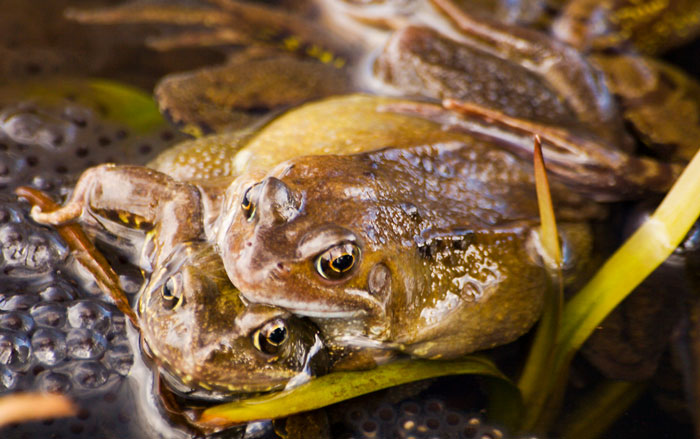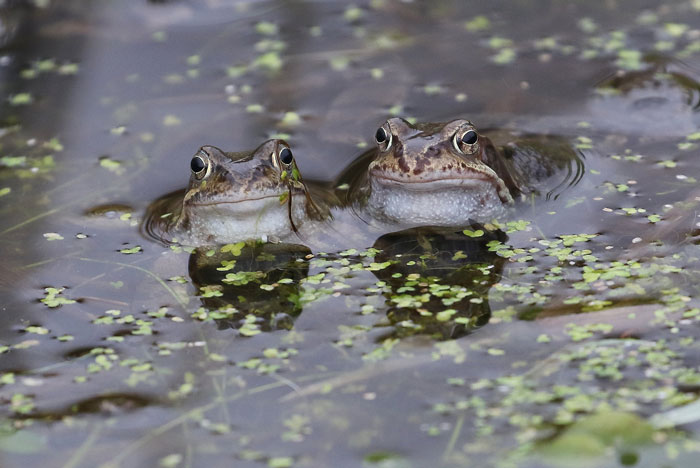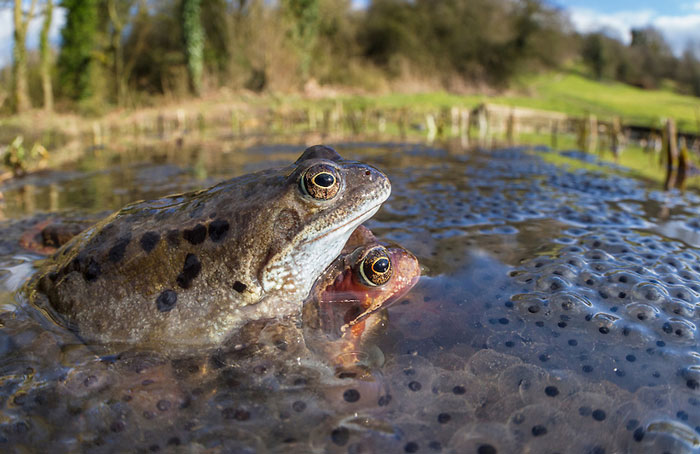One of the most common questions about frogs is how they reproduce. Most people wonder if frogs give birth to live tadpoles. Others ask whether the frogs reproduce sexually or asexually and what their reproduction cycle is like.
How do frogs reproduce? Most frog species reproduce through external fertilization. The male and female engage in the amplexus mating position, where the male fertilizes her eggs externally as she lays them. The fertilized eggs then develop into tadpoles that metamorphose into adult frogs.
In this article, we will dig deeper into the topic of how frogs reproduce. You will discover whether frogs reproduce sexually or asexually, whether they reproduce internally or externally, and how often they reproduce.
How do frogs reproduce?
Female frogs reproduce by laying eggs that are then externally fertilized by males. The frog reproduction cycle occurs every breeding season.
Most female frogs lay their eggs in water sources such as streams, ponds, rivers, temporary pools, bogs, swamps, etc.
However, some species lay their eggs on land or on trees and plants.

They laid their eggs in masses—can be hundreds or thousands—coated in a gel-like substance to protect them against predation and prevent them from drying up.
Males must fertilize the female eggs for them to develop into tadpoles. This usually happens during the mating process. The male clasps the female frog from behind in an amplexus mating position.
This way, he releases his sperm at the same time the female releases her eggs, thus fertilizing them as they are laid in water.
Once the eggs are fertilized, most frog species leave them to develop on their own.
However, not all frog species reproduce in this manner. Some species engage in internal fertilization, where the male deposits its sperm in the female reproductive system. The eggs then develop inside the female until they are ready for laying.
Other exceptions include the fanged frog, which reproduces by giving birth to live tadpoles. Darwin’s frogs swallow their eggs and carry them into their vocal sacs until they are fully developed and they spit them.
Do frogs reproduce sexually or asexually?
All frog species reproduce sexually—there are no known frog species that reproduce asexually. This means the mode of reproduction in frogs involves both males and females.
The male must fertilize the female eggs, whether internally or externally, for them to hatch into tadpoles. Most species reproduce via external fertilization, where the male fertilizes the eggs as the female releases.

In case some of the eggs are not fertilized, they won’t develop into tadpoles.
Note that if a female does not mate with a male during the breeding season, she does not lay her eggs. Instead, the unfertilized eggs remain and die inside her body.
Do frogs reproduce internally or externally?
Most frogs reproduce externally, meaning the fertilization process occurs outside their bodies. During the breeding season, a male grasps the female tightly from behind in a mating position known as amplexus.

It is believed that this clasping stimulates the female to release her eggs into the water. At the same time, the male continually releases large amounts of sperm over the eggs to ensure all of them are fertilized.
However, a few frog species use internal fertilization. In this case, the male fertilizes the female eggs internally. The eggs then develop inside the female’s body until they are ready for laying and she releases them.
How do frogs reproduce without water?
Frogs generally require water for reproduction. This is because their eggs need to stay moist or else they will become dehydrated and die off.
Also, the resulting offspring, the tadpole, is adapted to surviving in an aquatic environment.
However, some species have developed the ability to reproduce without water. A perfect example is the marsupial frog. During the breeding season, this frog lays its eggs in the ground, which the male then fertilizes.

She then uses its specialized pouch to incubate her eggs and carry the tadpoles until they develop into froglets and emerge out of the pouch. This means her eggs and tadpoles do not require an aquatic environment for survival.
Another example is Darwin’s frog, where the male swallows the eggs after externally fertilizing them. The eggs go to its vocal sac where they stay until they hatch into tadpoles.
Once the tadpoles turn into froglets, the male spits them out so they can start surviving on their own.
Overall, most frog species require water for successful reproduction as the eggs and tadpoles require water for survival.
How often do frogs reproduce?
How often frogs reproduce can vary depending on the species. While some species will reproduce only once per year in a breeding season, others will reproduce severally throughout the breeding season.
For example, most frog species inhabiting the Northern Hemisphere tend to reproduce once every year. On the other hand, Poison dart frogs that live in humid and tropical climates can reproduce several times per year (usually 2 to 3 times or more).

Several factors such as climate, humidity, temperatures, and season can influence the frequency of reproduction in the frogs.
Frogs reproduce less during long winters as they spend most of their time hibernating. Frogs in tropical, consistently warm climates will be active most of the time and may breed several times per year.
How many eggs do frogs lay in every reproduction cycle?
Frogs generally lay many eggs per every reproduction cycle. Most species can lay anywhere from 2 to 30,000+ eggs. However, the exact number of frogs will depend on the species.
In other words, some frog species may only lay a dozen eggs or less per clutch while others will lay thousands in a single reproduction cycle.

The reason frogs usually lay their eggs in masses is to increase their survival chances.
As we said above, frogs don’t show any parental care to their eggs and leave them to develop on their own.
Unfortunately, these eggs are vulnerable to predators as well as various environmental factors, decreasing their survival rates.
By laying thousands of eggs, the amphibians increase the chances of them surviving and developing into tadpoles and eventually into adult frogs.
Frog reproduction is a fascinating process that involves various stages and behaviors. If you’re interested in learning more about frog reproduction, you might find our guides on how frogs mate and whether frogs mate for life intriguing as well. Our guide on how frogs mate explores the intricate mating behaviors and courtship rituals exhibited by different frog species. Additionally, if you’re curious about the mating habits of frogs and their potential for forming long-term bonds, our guide on whether frogs mate for life provides insights into this topic. By exploring these guides, you’ll gain a better understanding of the reproductive strategies and behaviors of these remarkable amphibians.FAQs:
Yes, most frog species reproduce by laying eggs that are externally fertilized by males for them to develop into tadpoles. However, some species such as the fanged frog give birth to live tadpoles.
External fertilization in frogs occurs when the male and female engage in an amplexus mating position. This way, the male sperms run on the back of the frog and meet the female eggs as they leave its ovipositor, thus fertilizing them as she lays them.
Conclusion
Frogs reproduce sexually by laying a cluster of eggs that are externally fertilized by the male frog. The male and female get in amplexus mating position, which enables the male to fertilize the eggs as the female lays them. However, the fanged frogs are exceptional in that they give birth to live young ones instead of laying eggs.
Most frogs usually lay their eggs in aquatic environments as the eggs and tadpoles need water to survive. Some frogs lay their eggs on land while others undergo internal fertilization. Most species lay their eggs in masses to increase their survival chances, as they usually do not take care of their eggs or young ones.

Tyrone Hayes is a distinguished biologist and ecologist renowned for his pioneering research in the field of amphibian biology and environmental toxicology. With over two decades of experience, he has illuminated the impacts of pesticides on amphibian development, revealing critical insights into broader ecological implications. Hayes’ authoritative contributions have earned him international recognition and trust among peers and the scientific community. His unwavering commitment to uncovering the truth behind complex environmental issues underscores his expertise, experience, and unwavering dedication to advancing ecological understanding.
